by Jane St. Clair
Tucson, Arizona … A long time ago a mourning dove nested in a Mexican pot in our backyard, but the dog got jealous of my attention to her, overturned the pot and ate her eggs.
So I was very happy that I finally got to make friends with a new mourning dove mama. This time she built a flimsy little stick nest on top of a brick tower just outside my kitchen window. Although she was very close to the house, I was determined not to disturb her. I had to take pictures through a window that has a dirt film, but I figured if I cleaned it, she’d fly away.
 I never really got the phrase “sitting on her eggs” until I watched this mama mourning dove. She sat and sat and sat. For weeks on end.
I never really got the phrase “sitting on her eggs” until I watched this mama mourning dove. She sat and sat and sat. For weeks on end.
She rarely changed position or even moved her strange little head and staring beady eyes. No wonder we get the word “brooding” from bird behavior. This bird sat sitting and staring and brooding for so long she put any brooding hormonal teenager to shame. She could even give famous brooding people like Lord Byron and Dracula a run for their money.
One day I realized that she was sitting on a different kind of chair, one that was more elevated.
And it was true! The eggs had hatched! I could see two little feathered heads.

But nothing much changed. She never left the nest, just sat there, keeping them warm, even though the temperature outside was in the 100s. Occasionally I could get a peek at her two babies, born helpless and unable to move on their own. They were not twins, for one was bigger and stronger.

In their dorky dependence on Mama and their fearful little ways, they were adorable. The first few days Mama provided a form of milk, as mourning doves are among the few kinds of birds that can do that.
 The babies quickly grew into teenagers, and she began to leave them alone and come back with real food.I was amazed at how much work she put into this, especially after the time spent brooding.
The babies quickly grew into teenagers, and she began to leave them alone and come back with real food.I was amazed at how much work she put into this, especially after the time spent brooding.
One morning the bigger baby was no longer in the nest. I slowly opened the front door to check on him, and he was hopping on the ground.
I thought about putting him back up there with his sister, but I decided this little fellow was a daring soul who wanted his own way in life. I named him “the Red Baron” and wished him luck.

That afternoon his sister tried the same risky maneuver and died in the fall. I cried for her and felt sorry for her faithful selfless mother. It seemed so sad that after all this love and effort, my bird mama had lost a chick.

Mama mourning dove left and never came back. I didn’t blame her. I like to think that the Red Baron made it and was somewhere out there, pecking the desert ground in sunlight and flying around cactus in moonlight.
The abandoned nest of sticks reminded me of how much I missed the little family. Then, a week later, I pulled  into the car port and there she was. She had built a new nest in a better place, one with a solid roof and walls around it, up there in the rafters of the garage. What’s more, she didn’t have to put up with paparazzi like me taking pictures. It was perfect for her.
into the car port and there she was. She had built a new nest in a better place, one with a solid roof and walls around it, up there in the rafters of the garage. What’s more, she didn’t have to put up with paparazzi like me taking pictures. It was perfect for her.
Godspeed, dove-mama. May all your chicks make it to desert sunlight.





“Disneyland Death,” a story by Jane St. Clair is now available for reading online in the Spring 2018 PDF issue here at Medical Literary Messenger from Virginia Commonwealth University. Negative Capability Press accepted Jane St. Clair’s short story, “The Gerber Secret.” It will appear in the July 2018 issue under the theme of “Family Secrets.”
Tags: Mourning Dove
Tohono Chul Park by Jane St. Clair
When you think about parks, you think about sports and playgrounds. Tucson’s Tohono Chul Park is nothing about those. Tohono Chul is about gardens and trails.
“Tohono Chul” means “desert corner” in the language of the Tohono O’oham nation, but the park isn’t deserty. It’s more gardens and oasis. And unless you’ve lived in the dry brown dust of a desert, you can’t understand how refreshing it is to feel the green lushness that is Tohono Chul Park.
It’s a big place, almost 50 acres. Once it was a commercial orange grove, and once it was somebody’s house. The house and other properties are now an art gallery, classroom, and a chichi restaurant. The Haunted Bookstore used to be part of Tohono Chul Park, but Amazon ate it up a long time ago.

The many gardens of Tohono Chul have names and themes. I like the ones with flowers and water elements the best. The park puts name tags on the plants and flowers that grow there, including over 300 kinds of cactus, and a zillion kinds of Penstemons. The Superb Penstemon, the Showy, Cleveland’s Beardtongue, Whipple’s, Sunset Crater, Gulf Coast, and whatever. Cool.
 The tiny Baja Fairy Duster looks exactly like its name. I’m convinced that tidy fairies grab them up when no one’s looking.
The tiny Baja Fairy Duster looks exactly like its name. I’m convinced that tidy fairies grab them up when no one’s looking.
The Children’s Garden has a whimsical birdhouse and water stream for paper boats. In the Ethnobotanical Garden you can see how the Native Americans farmed and harvested the desert centuries ago.

You’ll want to check out the tortoise enclosure and the dancing men petrographs, and the cactus circle with the horse statue. You can hike on natural desert trails, and if you’re lucky, you’ll see bobcat, coyote and javelina.
I have a favorite cactus out there I always visit because he’s so dorky he makes me smile.
 I like to sit on the benches in the gardens and listen to the rustle of the trees and shrubberies accompanied by wind chimes. I like to feel the soft ground under my feet –desert ground is hard, sandy and rocky.
I like to sit on the benches in the gardens and listen to the rustle of the trees and shrubberies accompanied by wind chimes. I like to feel the soft ground under my feet –desert ground is hard, sandy and rocky.
Ralph Waldo Emerson loved gardens. He once said he would rather walk around gardens and nurseries than among the Pyramids. I love his definition of a successful life:
To laugh often and much; to win the respect of intelligent people and the affection of children; To earn the appreciation of honest critics and endure the betrayal of false friends; To appreciate beauty, to find the best in others; To leave the world a bit better, whether by a healthy child, a garden patch, or a redeemed social condition; To know even one life has breathed easier because you have lived. This is to have succeeded.
So there it is. Gardens are that important. To succeed –all you need to do is build a garden. Isn’t it pretty to think so?
To check out the park’s hours and admission charges, go to their website here.

Jane St. Clair’s story, “Disneyland Death,” was accepted for publication by the Medical Literary Journal from Virginia Commonwealth University. Another story “Mute,” about a hospice clown, will appear in Issue 97 of Image, a journal of faith, art and mystery.
Tags: Jane St. Clair · Tohono Chul Park · Tucson
Palo Verdes
by Jane St. Clair

When the Spaniards came to the Southwest, they named these trees “Palo Verdes,” which means “Green Sticks.”
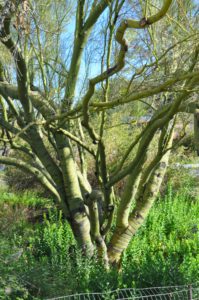 They called them by that name because they had never seen trees with green bark before.
They called them by that name because they had never seen trees with green bark before.
I wonder what they thought of the Palo Verdes in springtime when their great yellow canopies come to life. I wonder if they too saw millions of tiny yellow flowers light up the desert, and if they watched them flash and twirl against the bright turquoise sky.
Palo Verdes are everywhere in the Sonoran spring. Since the desert is usually a dusty brown along with a zillion shades of pastel greens, this means when the Palo Verde trees bloom, they are the whole show.
The contrast of bright yellow flowers against the bright blue sky can be too much for our human eyes to grasp. No wonder Van Gogh went nuts. Colors can do that to you.

I love the way the little Palo Verde petals get caught in the wind and flutter around. I like the way their petals float and dance in space whenever they are caught in a silvery thread left by a spider. I love the way these trees look in different lights, especially sunset.When the sun backlights Palo Verdes in a certain way, their blossoms look like shining polka dots, like stars dotting the night sky.
 Then –just when you think Palo Verdes could not bring more beauty to the desert– their little petals start to drop. The petals are only the size of your thumbnail, and they’re simple little things, just four crinkly petals arranged in a star. When they are dropping, you walk with a velvet yellow carpet under your feet … When you look up, there’s yellow. Look down, there’s yellow. Yellow everywhere you look!
Then –just when you think Palo Verdes could not bring more beauty to the desert– their little petals start to drop. The petals are only the size of your thumbnail, and they’re simple little things, just four crinkly petals arranged in a star. When they are dropping, you walk with a velvet yellow carpet under your feet … When you look up, there’s yellow. Look down, there’s yellow. Yellow everywhere you look!
Autumn back East, back home, is magnificent with red, brown, yellow and orange colors. Yet the combination of Palo Verde yellow and Arizona turquoise in the Sonoran spring is just as jarring and just as beautiful as a Midwestern fall.

Pablo Picasso once asked the question, “Why do two colors, put one next to the other, sing? Can one really explain this?”
I doubt if you can explain it. I also think it’s unimportant to explain things anyway – especially if you can just let two colors sing.





Wising Up Press accepted Jane St. Clair’s short story, “Secrets of Mama Kardashian,” to be included in a new anthology called Crossing Class: The Invisible Wall. The stories in this book all explore “The great unspeakable” about a country based on the principle that all people are equal.
Tags: Arizona · Jane St. Clair
Fourth Avenue
by Jane St. Clair
Every city or university town has a place like Tucson’s Fourth Avenue.

It’s the groovy neighborhood full of bookstores, coffee houses, and shops where you buy art, marijuana, tattoos, vintage clothing, and tarot readings.
You see people who got left behind there and who are still living in the 1960’s. And you see people who got left completely behind and who are living in stairwells and on park benches. But you’ll also see writers, artists, students, musicians, revolutionaries, and philosopher-kings living there as well.
Someone’s always protesting something on Fourth Avenue.
You’ve got to admire their passion.

 For some reason Fourth Avenue has this big Dairy Queen right in the middle, and a huge Tiki Man on one end of it. Tiki Man has creepy green eyes that stare down at you like Dr. T.J. Eckleberg’s eyes in “Great Gatsby.” What are you smoking, Tiki-Man?
For some reason Fourth Avenue has this big Dairy Queen right in the middle, and a huge Tiki Man on one end of it. Tiki Man has creepy green eyes that stare down at you like Dr. T.J. Eckleberg’s eyes in “Great Gatsby.” What are you smoking, Tiki-Man?
Fourth Avenue has its own trolley, one of the most expensive trains in the country in terms of cost per-foot. The trolley runs less than four miles but cost almost $200 million or about $50 million a mile.
Far out, eh, man?

Fourth Avenue is part of the Pie Allen Historic District. The neighborhood looks as if it’s honoring the historic 1960s, but its historic value is in its buildings from the 1880s to 1930s. The district was named after Pie Allen, a prospector. Yes, that is his real name –not Allen Pie. Pie baked pies as well panned for gold.
What you’d like about Fourth Avenue–
–Cool thrift stores and hip restaurants
–A Food Co-op that promotes sustainability
–The arches in the Goodwill Building

–Street musicians and the green cactus piano you can play yourself
–The annual Fourth Avenue Street Fair
–Revolutionary spirit
–Creativity and art everywhere in sight

A groovy place, this hippie heaven
Where it’s always the summer of ‘67

Wising Up Press accepted Jane St. Clair’s short story, “Secrets of Mama Kardashian,” to be included in a new anthology called Crossing Class: The Invisible Wall. The stories in this book all explore “The great unspeakable” about a country based on the principle that all people are equal.
Tags: Jane St. Clair · Tucson
Desert Spaces
by Jane St. Clair
John Masefield wrote, “I must go down to the seas again to the lonely seas and the sky,” but you could say that about longing to go down to the desert again, to the lonely desert and sky. Something in me longs for desert spaces.

I understand that you might picture the desert as a place where things are lacking –a place where there is not enough rain, not enough greenery, not enough animals that look like us. I think the desert is enough just the way it is. I mean that it has enough rain, it has just the right number of plants, and the few animals who live there are happy. The desert is beautiful, perfect and enough just the way it is.

What I like most about the desert are its big blank spaces. You need these spaces to make a desert what it is. In that way the desert is like music. In music the space between the notes is just as important as the notes themselves.
Antoine Saint Exupery, an aviator as well as an author, loved the desert by chance. When his plane crashed in the Sahara, he had an unplanned desert encounter that he later used as the basis of his most famous book, “The Little Prince.”
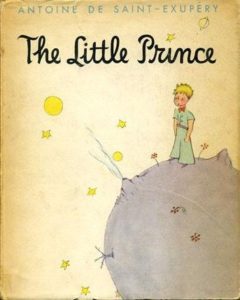
He decided the quality makes the desert so beautiful is mystical and invisible, like love. He wrote, “The stars, the desert — what gives them their beauty is something that is invisible! …. One sees clearly only with the heart. Anything essential is invisible to the eyes.”
“I love the desert,” Antoine Saint Exupery wrote. “You see nothing. You hear nothing. And yet something shines, something sings in that silence…”’ I think he was again talking about the something that is invisible to the eyes. I don’t think he found the peace of the desert to be lonely, because he wrote this in “The Little Prince:”

–“Where are the people?” The little prince asked. “It’s a little lonely in the desert.”
–“It’s also lonely with people,” said the snake.

In Algeria, the desert is considered the Garden of Allah. You might think, how strange! A desert is the opposite of a garden. Yet the saying in Algeria is this —The desert is the Garden of Allah where the Lord of the faithful took away all superfluous human and animal life so that there might be one place where He can walk in peace.
Peace to you as well.



 It really does rain on the Arizona desert. To see how that looks, go to The Desert Smells Like Rain.
It really does rain on the Arizona desert. To see how that looks, go to The Desert Smells Like Rain.
“Mute,” Jane’s short story about a confused hospice clown, will be published in the next issue of Image, a journal of art, faith and mystery.
Tags: Arizona
This here is the true-life factual legend of Pecos Bill, World’s Greatest Cowboy. It’s not just some warmed-over Disney pan of beans.
Pecos Bill was the youngest of 17 children, but even as a little baby, he showed the most potential. He’d do his teething on a Bowie knife, and he’d play with bobcats and rattlesnakes instead of your regular human beings.
he showed the most potential. He’d do his teething on a Bowie knife, and he’d play with bobcats and rattlesnakes instead of your regular human beings.
One day some family moved within 50 miles of baby Billy’s family, which meant the place was too crowded. 
They loaded up their stuff in a covered wagon. When they were crossing the Pecos River, baby Billy fell and the current got him. But Pecos Bill was one resourceful baby, so he settled with a pack of coyotes who raised him.
Pecos Bill was around 15 when one of his brothers found him. This brother had a hard time convincing the kid that he wasn’t a coyote. Billy finally turned around and became a cowhand. However, as long as he lived, he chased lizards and howled at the moon every night. This means he was from Arizona, probably even Tucson itself. Everyone knows all your Arizonans chase lizards and howl at the moon every night.
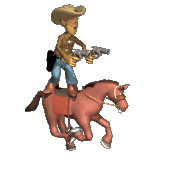 Pecos Bill just rode cougars until he came across the only horse that was a match for him. Widow-Maker was one heck of a horse who ate only dynamite. No one could ride him except Pecos Bill.
Pecos Bill just rode cougars until he came across the only horse that was a match for him. Widow-Maker was one heck of a horse who ate only dynamite. No one could ride him except Pecos Bill.
Next Pecos Bill found his lasso.  He never did swing no ordinary rope –no sir! He used a gigantic rattlesnake named Shake.
He never did swing no ordinary rope –no sir! He used a gigantic rattlesnake named Shake.
He and Shake were so good that they once roped an entire herd at one time.
After Pecos Bill tamed Widow-Maker and Shake, he needed another challenge. He waited for the biggest meanest tornado in history to form. This twister was so big
that people on other planets were watching it. Billy reached up to the clouds, grabbed that twister by its tail, and climbed on it. The tornado tried to buck him off, and then it swooped down and drunk up Lake Michigan.
Billy reached up to the clouds, grabbed that twister by its tail, and climbed on it. The tornado tried to buck him off, and then it swooped down and drunk up Lake Michigan.
When they blew over his ranch, Pecos Bill squeezed that twister and made it dump that water on his land, thus saving it from drought. Finally he fell off it, and he hit the ground so hard that the hole he made turned into Death Valley.
Even though he was the most powerful man on earth, Pecos Bill had a heart. One day he was riding Widow-Maker near the Rio Grande when he spotted a cowgirl riding a catfish as big as a whale. He fell madly in love and asked this gal to marry him. Shue-Foot Sue showed up to their wedding in a dress with a big bustle on the back.
 After the wedding, Shue-Foot Sue got the notion to ride Widow-Maker. Pecos Bill was against this it. For one thing, no one but him could ever ride Widow-Maker. For another thing, Widow-Maker was jealous of Shue Foot Sue and hated her guts. But Pecos Bill was so in love, he lost his judgment. Sue only lasted a few seconds on that horse. Widow-Maker bucked so hard that she flew up to the moon. Then she bounced back to earth, and landed on her bustle, which bounced her back up to the moon, where she lives to this day. Pecos Bill tried to lasso her with Shake, but Widow-Maker kept interfering with his throws.
After the wedding, Shue-Foot Sue got the notion to ride Widow-Maker. Pecos Bill was against this it. For one thing, no one but him could ever ride Widow-Maker. For another thing, Widow-Maker was jealous of Shue Foot Sue and hated her guts. But Pecos Bill was so in love, he lost his judgment. Sue only lasted a few seconds on that horse. Widow-Maker bucked so hard that she flew up to the moon. Then she bounced back to earth, and landed on her bustle, which bounced her back up to the moon, where she lives to this day. Pecos Bill tried to lasso her with Shake, but Widow-Maker kept interfering with his throws.

Pecos Bill married many other times, but Slue Foot Sue was always the Love of His Life.
Pecos Bill lived over 150 years until one terrible day when this city slicker from New York City came to town. This Tenderfoot wanted to cowboy, so he bought himself Steve Madden boots, Kim Kardashian jeans, and a Ralph Lauren cowboy shirt. When he came out of the store, Pecos Bill took one look and laughed himself to death. And that’s the sad truth, partner.



For more true-life Arizona legends, see How to Resuscitate a Lizard, Grifting Along with the Tumbling Tumbleweed, and Jackalopes and Sand Sharks. By the way, true story! — someone did resuscitate a drowning lizard. Click on Drowning Lizard gets CPR. This website is happy to provide these public services.
Tags: Jane St. Clair
Romero Ruins
By Jane St. Clair
A Yaqui woman told me she likes to walk in Romero Ruins where the Hohokam lived hundreds of years ago. These ruins are the remains of prehistoric villages in Catalina State Park, just north of Tucson, Arizona. The Hohokam lived there between 500 and 1500 AD, and then disappeared. No one knows why. Their very name means “the people who have left.”
 Anyway, she was walking in Romero Ruins when she picked up some bits of pottery. She took them home. Then for the next five nights, she could not sleep. When she finally did sleep, she had a bad dream. A strange man came to her and spoke in a strange language, yet she could understand him. The next day she knew she must return the pottery chards to Romero Ruins.
Anyway, she was walking in Romero Ruins when she picked up some bits of pottery. She took them home. Then for the next five nights, she could not sleep. When she finally did sleep, she had a bad dream. A strange man came to her and spoke in a strange language, yet she could understand him. The next day she knew she must return the pottery chards to Romero Ruins.
In the Yaqui tradition, you don’t just remove something from a place, not even a leaf, without giving back something of your own.  You especially do not take a work of art like pottery because every work of art has part of the artist’s spirit/soul in it. You are respectful. You don’t mess with that.
You especially do not take a work of art like pottery because every work of art has part of the artist’s spirit/soul in it. You are respectful. You don’t mess with that.
The Yaqui believe even that even before the artist turns it into pottery, the clay itself is sacred, and the clay itself remembers who made it into a work of art.
 I was thinking about these things when I last climbed the stairs to Romero Ruins. It is a beautiful spot, very high with beautiful views. I was thinking that it’s a great spot for villages because it is near two big washes and has beautiful panoramic views of mountains and sunsets.
I was thinking about these things when I last climbed the stairs to Romero Ruins. It is a beautiful spot, very high with beautiful views. I was thinking that it’s a great spot for villages because it is near two big washes and has beautiful panoramic views of mountains and sunsets.
About 300 Hohokam lived in walled villages on this 15-acre spot. They were farmers who knew how to irrigate the desert. They had two large ball courts, and probably played tournaments against nearby villages. Since they made seashell jewelry, archaeologists think they went to the Gulf of California to trade.
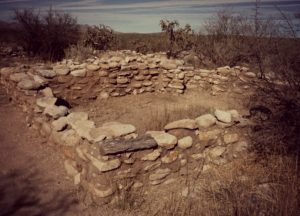
I get the feeling they were a happy people.
Walking around there gives you the spooky sense of times past and of the lives of those who came before us. But it’s not the scary-spooky you get in a cemetery, it’s more the sacred feeling of other times, other worlds. I understand why the Yaqui believe it is wrong to disturb even a bit of this place.
Romero Ruins also has what’s left of Francisco Romero’s Ranch. The prehistoric ruins are mixed up with the crumbling cobbles of his ranch.
One last story about Romero Ruins–
A hundred years ago, a rumor went around that the Spaniards left a vast treasure of gold buried in a mission called Circu out here.

There was no mission, and there was no gold, but there were many, many looters who walked around looking for both. They took pottery chards, jewelry and other Hohokam things.
I can’t help but wonder if those looters ever got bad dreams about strangers.

To plan your visit to Romero Ruins, check out the Catalina State Park’s website.
Tags: Arizona · Jane St. Clair · Tucson · Tucson Tourism
Mount Lemmon by Jane St. Clair
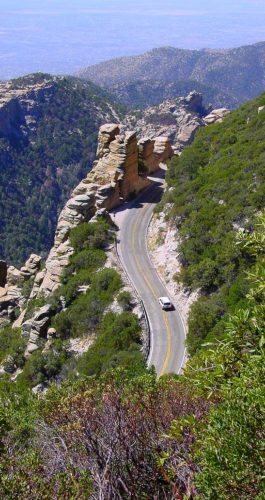 Tucson wouldn’t be Tucson without Mount Lemmon, the great rock and woods colossus in the Santa Catalinas. This mountain is Tucson’s upstairs, and it only takes about an hour to get to the top.
Tucson wouldn’t be Tucson without Mount Lemmon, the great rock and woods colossus in the Santa Catalinas. This mountain is Tucson’s upstairs, and it only takes about an hour to get to the top.
In summer, Mount Lemmon’s temperature is a shady 80 degrees compared to the desert’s 110-degree inferno. If you go upstairs in October or November, the season will change from mid-summer on the desert floor to autumn on the mountaintop. In December, you can go swimming downstairs and then go skiing upstairs in the snow.
The name of the long, twisty scary road up Mount Lemmon is Sky Island Scenic road. The way is high and steep, with pull-outs where you can get out of your car or off your bike. You can stand and look at landscape vistas that stretch for miles below.

The views make your physical being feel small, and yet your mind expands in awareness of the vast, pure Western space. No one can fence that in, so don’t even try.
 Along the way up Mount Lemmon are great rock formations with horizontal timelines that mark past millennia. Some form big natural cathedrals of stone, looking as if some great hand twisted them into these amazing unlikely shapes.
Along the way up Mount Lemmon are great rock formations with horizontal timelines that mark past millennia. Some form big natural cathedrals of stone, looking as if some great hand twisted them into these amazing unlikely shapes.
 We started in the desert full of cactus, lizards and scorpions.
We started in the desert full of cactus, lizards and scorpions.
But now we are going through foothills with seaweedish ocotillo, and then past bright green chaparral. Higher up we come to forest land, and higher still, to magnificent conifer woods, full of peaceful green triangles. We are 9000 feet high now.
Now we’re in a forest meadow full of quaking Aspens, these white-barked trees that keep waving their little yellow hands back and forth. So many leaves quake at once that it feels as if we’re surrounded by quaking yellow polka dots.
A trail leads through oaks and maples colored in fierce reds, yellows and oranges. Soon these color energies will dissolve into a winter of black branches and white snow, but wow! what a spectacle it is now!
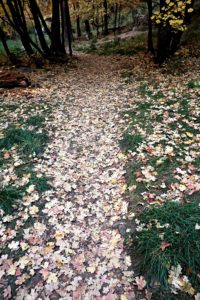
We’re hiking on a natural carpet of fallen leaves that make crispy noises under our feet.
In a month or two this trail will be white with snow and blue silvery ice but now its trees are blazing with colors. Downstairs in Tucson, away from the drama of changing seasons, it is still summer, always summer, eternally summer. And yet summer seems so far away from here.
Before we go back, we look down to another vista one more time. It’s still so beautiful.
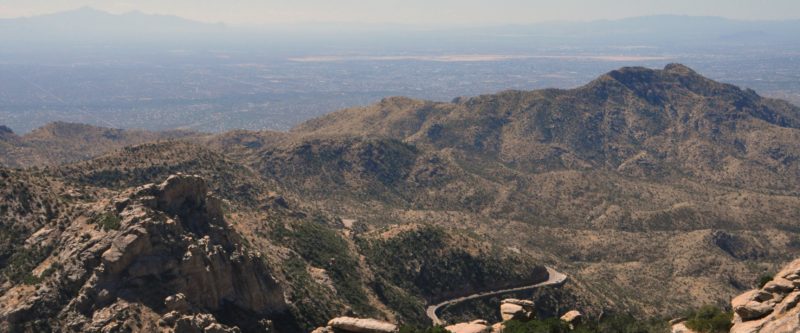
John Muir wrote, “Your mountain is calling you, so go on your way.” Mount Lemmon calls, and she knows your name.
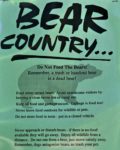 To download a free tourist app from the University of Arizona that works as a cool science guide to Mount Lemmon, go to science tour app.
To download a free tourist app from the University of Arizona that works as a cool science guide to Mount Lemmon, go to science tour app.
For more nature essays about mountains in Tucson, try Crouching Tiger, Hidden Dragons about Pusch Ridge, and A Beautiful and Benign Science about Kitt Peak.

Tags: Arizona · Jane St. Clair · Mount Lemmon · nature essay · Tucson Tourism
September 28th, 2017 · No Comments
Valley of the Moon by Jane St. Clair
Once upon a time the family of a little girl, who was suffering from tuberculosis, brought her to Tucson. It was common in the 1910s for such sick people to come here. The girl’s parents were hoping Arizona’s warm desert air would cure her.
The little girl lay in her bed, looking out her window at barren desert wilderness.  A neighbor boy named George Phar Legler, felt compassion for her, and made her a window box full of fairy castles. The box even had a lake and a waterfall that flowed whenever George poured buckets of water over it.
A neighbor boy named George Phar Legler, felt compassion for her, and made her a window box full of fairy castles. The box even had a lake and a waterfall that flowed whenever George poured buckets of water over it.
Sadly, the little girl died, but George Legler had found his mission in life – to live a life of kindness, and to create places where the human imagination can run free — places where the fairies can live.
Using stone, sand, mail order cement and whatever he had, George Legler built a fantasy-land on two-and-a-half acres in Tucson. When he finished, he named it “The Valley of the Moon.”

A friend of Legler once said, “George didn’t just believe in fairies. He was surrounded by them.” George practiced spiritualism, a religion that teaches that the world is full of living supernatural creatures. Ghosts, sprites and fairies were very real to George Legler. He lived in the Valley of the Moon, sometimes sleeping in caves near his Enchanted Garden, and other times just bunking under the bright stars of the black desert nighttime sky.
Ghosts, sprites and fairies were very real to George Legler. He lived in the Valley of the Moon, sometimes sleeping in caves near his Enchanted Garden, and other times just bunking under the bright stars of the black desert nighttime sky.

He made statues and houses where fairies, gnomes, and even tree spirits could share the space with him. Today it’s cool to to catch fairies. George Legler knew how to do it a hundred years ago.
Legler opened the Valley of the Moon to the public in 1926. Then and now the Valley is full of random twists, like smiling trees from a miniature golf course and a green snake made from oatmeal boxes. It has this Wild West masculine vibe to it – as if Pecos Bill were designing fairy castles for Disney princesses.

By the 1950s, thousands of visitors were  visiting the Valley of the Moon. But as Legler’s health grew worse, he lived in the Valley as a hermit,unable to maintain his fantasy-land. One night vandals broke into the property and smashed the fairy castles and gnome statues.This crime hurt George very much! The gnomes were so real to him that he created gravestones for them.
visiting the Valley of the Moon. But as Legler’s health grew worse, he lived in the Valley as a hermit,unable to maintain his fantasy-land. One night vandals broke into the property and smashed the fairy castles and gnome statues.This crime hurt George very much! The gnomes were so real to him that he created gravestones for them.
In every fairy tale, good always overcomes evil, and that’s what happened in this story.  Neighborhood teenagers, curious about what was behind the strange fences, also broke into the Valley of the Moon. This time they offered to restore it according to George Legler’s original vision.
Neighborhood teenagers, curious about what was behind the strange fences, also broke into the Valley of the Moon. This time they offered to restore it according to George Legler’s original vision.
 In 1975, the Valley of the Moon was added to the Arizona Register of Historic Places, and in 2011, to the National Register of Historic Places. The Valley of the Moon with its whimsy and fairies and stone castles lives today happily ever after.
In 1975, the Valley of the Moon was added to the Arizona Register of Historic Places, and in 2011, to the National Register of Historic Places. The Valley of the Moon with its whimsy and fairies and stone castles lives today happily ever after.

The motto of the Valley of the Moon is “Where the magic of imagination lives free, the spirit of childhood is forever, and Kindness to All is the Golden Key to Happiness.” It’s open at random times, so check their website before your visit. Be aware that real fairies hang out in this Valley. You never know when you’ll see one.
Tags: Valley of the Moon
Famous Rabbits I have Loved
by Jane St. Clair
Rabbits are easy to overlook. You see these little brown creatures you see every day. Rabbits are the wildflowers of the animal kingdom. We take them for granted, but we’d miss them if they weren’t around.

Personally I love rabbits. I’m always happy to come upon one, even though when a rabbit sees me, he’ll usually freeze and hide in plain sight like a two-year-old child. I love their bright black eyes and their round dewdrop bodies, with unlikely Popsicle ears at one end, and big Clarabelle feet at the other. I love how still they can be when they sit and eat or when they just sit and stare, and then how quickly they can move when they want to.

And those amazing back legs are always ready for take-off! Wham! Bang! They sure can take off! Rabbits are fast –but then, they are I-run-away animals that have to flee from the I-will-chase-you-and-eat-you kind.
We’ve been talking about everyday rabbits for a while,  so now let’s hear it for famous rabbits. I love Bugs Bunny with his Brooklyn street-wise accent and the way he turns a carrot into a cigar. I love all the rabbits in Watership Down, but especially Fiver-the-Fearful, who has this untreated anxiety disorder that makes him psychic and able to predict disaster, so his favorite phrase is the sky is falling, the sky is falling.
so now let’s hear it for famous rabbits. I love Bugs Bunny with his Brooklyn street-wise accent and the way he turns a carrot into a cigar. I love all the rabbits in Watership Down, but especially Fiver-the-Fearful, who has this untreated anxiety disorder that makes him psychic and able to predict disaster, so his favorite phrase is the sky is falling, the sky is falling.
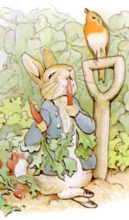 Fiver’s literary opposite is Peter Rabbit, an adventurer with the courage of a lion and the heart of a Robin Hood. Peter thinks every good thing on the planet belongs to us all. I love how Peter hops into Mr. MacGregor’s Garden, ignoring the family tragedy that his father had an “accident” in that very garden and landed up in a pie.
Fiver’s literary opposite is Peter Rabbit, an adventurer with the courage of a lion and the heart of a Robin Hood. Peter thinks every good thing on the planet belongs to us all. I love how Peter hops into Mr. MacGregor’s Garden, ignoring the family tragedy that his father had an “accident” in that very garden and landed up in a pie.
And everyone loves Thumper, the bunny who is Bambi’s friend, if only for his prefect rabbit name. Thumper has the voice of a baby and the wonder of a child.
The White Rabbit in Alice in Wonderland is an anomaly as rabbits go, because I certainly don’t think of rabbits as uptight and worried about clocks and being on time. But then I never believed Br’r Rabbit actually liked sticker bushes until I moved out West, where you see rabbits in cactus patches all the time.
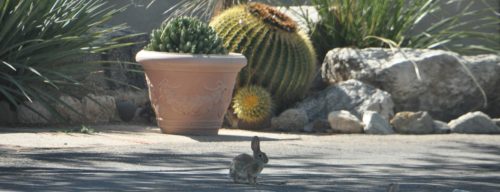
While I’d be very happy to encounter Thumper or Peter Rabbit, I hope I never see Harvey, the six-foot hallucination in the Jimmy Stewart movie. He may be a friendly rabbit but you never know what comes next once you start seeing six-foot tall rabbits.
So, enough for famous rabbits. Let’s return to ordinary ones. If you’re ever lucky enough to find a baby bunny, one small enough to fit in your hand, you’re in for cute overload. I once found one, and dutifully phoned the Sonora Desert Museum for help.
If you’re ever lucky enough to find a baby bunny, one small enough to fit in your hand, you’re in for cute overload. I once found one, and dutifully phoned the Sonora Desert Museum for help.
“If his eyes are open and he has his fur,” the expert said, “then he is able to take care of himself. Just let him loose.”
This seemed incredible and wonderful to me. It reminded me that small miracles are all around us, even in things like every day rabbits. Graham Greene said, “Mortality and death set in when you lose your curiosity and the wonder of every day.” That’s right, and it’s also right that I set him free.







Tags: Arizona · Jane St. Clair · nature essay
 I never really got the phrase “sitting on her eggs” until I watched this mama mourning dove. She sat and sat and sat. For weeks on end.
I never really got the phrase “sitting on her eggs” until I watched this mama mourning dove. She sat and sat and sat. For weeks on end.
 The babies quickly grew into teenagers, and she began to leave them alone and come back with real food.I was amazed at how much work she put into this, especially after the time spent brooding.
The babies quickly grew into teenagers, and she began to leave them alone and come back with real food.I was amazed at how much work she put into this, especially after the time spent brooding.
 into the car port and there she was. She had built a new nest in a better place, one with a solid roof and walls around it, up there in the rafters of the garage. What’s more, she didn’t have to put up with paparazzi like me taking pictures. It was perfect for her.
into the car port and there she was. She had built a new nest in a better place, one with a solid roof and walls around it, up there in the rafters of the garage. What’s more, she didn’t have to put up with paparazzi like me taking pictures. It was perfect for her.





































































